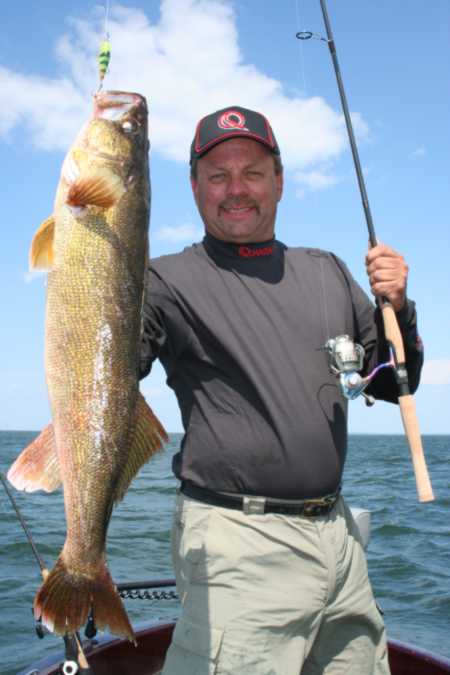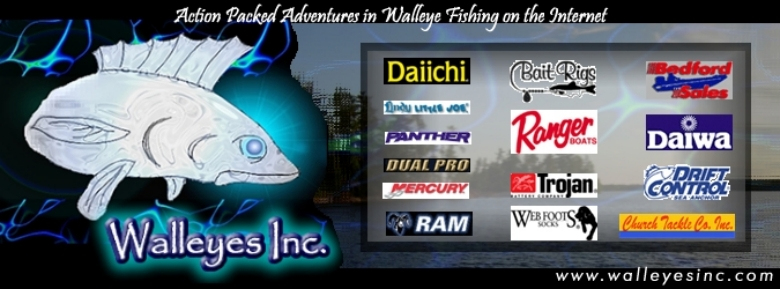| Editor's note: John Kolinski is the 2002 Professional
Walleye Trail Angler of the Year, the 2003 Illinois River
RCL winner and a 17-time championship qualifier. He is
the only anger to fish the PWT and B.A.S.S. at the same
time. His articles can be read in numerous Midwestern
outdoor publications and at several web sites. Kolinski
is sponsored by Triton Boats, Mercury Motors, Lowrance
Electronics, Yo-Zuri fishing line, Normark/Storm Lures,
MinnKota, Lindy Legendary Tackle, Tempress Rod Holders,
Off-Shore Planer Boards, Optima Batteries and Panther
Marine. |
Like a lot of anglers, I've got a crankbait for every occasion.
Spring calls for one set of baits. Summer brings another group
of plugs into play. Come fall, it's time to pull yet a different
box off the shelf in the garage.
In fact, I could probably change cranks 100 times for every
time I change my socks. And no, I don't always wait until my
footwear can stand upright before pulling on a fresh pair.
The point is, my arsenal of walleye lures is never set in stone.
It evolves depending on water clarity, water temperature, fish
location, presentation and most of all, forage.
And this time of year, bigger can be better. It's a season when
crankbaits that seldom see the light of day most of the year
often shine brighter than the smile of an angler holding a 10-pound
walleye.
There are many reasons big crankbaits work so well as the water
temperatures begin to cool.
First, big plugs match the available forage in the fall after
baitfish species like shad, alewife, chubs and minnows have
had a full season of growth. Second, fall walleyes are trying
to build reserves for the cold-water months ahead when their
metabolism slows and their foraging options are limited. Most
of know from experience that it's easier to fatten up by eating
several big meals a day and laying around in between rather
than burning the energy it takes to chase snack food all day
long.
To some degree, walleye location in October and November makes
big baits a more viable option, too. It wasn't efficient or
effective to troll or cast those cranks when the walleyes were
cruising the shallows in April or buried in the June weeds,
but they become a viable weapon when big-water eyes begin migrating
from the open water into bays and areas with shallower water
where they will spend the winter and spawn in the spring.

John Kolinski the author with a monster Walleye |
Within those areas, the fish relate to deep-water breaklines,
suspend off those breaks and move up onto weedy flats
to gorge themselves during low-light periods. All three
are prime locations for working big cranks.
In addition, the aggressive nature of fall fish and the
fact that they are often scattered as opposed to schooled
tightly means covering water will generally result in
more success. While a finesse presentation like a slow-trolled
crawler or a jigging approach on a specific piece of structure
will still take fish, this is one time of year when it
pays to keep on the move.Finally, fall means big walleyes,
and big walleyes like big meals. Trophy fish that simply
aren't accessible to anglers most of the year start to
turn up in predictable areas in numbers with a serious
appetite.
Of course, there has to be a strong population of giant
fish present in order to catch them. Fortunately, there
are a number of options including big reservoirs and the
Great Lakes. |
Big plug plans are a fall staple on the Bays de Noc, Green
Bay, Saginaw Bay and Lake Erie. Any successful strategy for
catching these fish should include a mix of casting and trolling
a select group of plugs that range from 6-8 inches in length.
My arsenal basically consists of Normark Husky Jerks, large
Tail Dancers and No. 9 Shad Raps, along with large Storm Thundersticks.
Tune every plug. It may be the most important thing you do
all day, and it only takes a few seconds. We've all heard
from other anglers or experienced situations ourselves where
there are four identical No. 9 Shad Raps at the same depth,
but one catches every fish. Chances are, it's simply tuned
better than the rest and is putting off the exact flash and
vibration to trigger strikes.
Catching a fish, especially a big one, can often knock a lure
out of tune. So, I tune my lures constantly by letting out
about eight feet of line, setting them in the water and pulling
them sharply forward while watching their action. If they
kick out at all in either direction they need an adjustment
of the eye ring where the line or swivel attaches to the crank.
Because water clarity tends to be better in the fall than
it is most of the year, I usually choose cranks that closely
parallel natural forage like perch, shad and shiners rather
than gaudy, bright patterns I might have used at other times
of the year.
Casting shallow-running versions of these plugs over the tops
of receding weed beds in October and November probably produces
more 28-inch and larger walleyes than any other pattern at
any other time of the year.
However, it's largely a night bite, and many anglers aren't
comfortable navigating unfamiliar shallow areas in the dark.
I've resolved that situation by using the mapping and GPS
functions of my Lowrance 113HD to chart a route into these
areas during daylight hours. Mark the path with waypoints,
save the trail and you'll have no trouble returning when the
sun has set.
These areas can also produce fish during the first hour or
two of the morning before they slide back to deeper water
and at dusk when the most eager walleyes try to get a jump
on their nighttime pillaging.
Trolling presentations are all about covering the water column
and finding the right style of lure. Use your electronics
to map out the contour and set up a trolling route. Then,
use deep-diving lures to probe the bottom, suspending baits
to cover the middle and shallow-running lures to find walleyes
that might be hanging just below the surface.
Lead-core line is a good way to get cranks to just about any
depth you will encounter. Even at depths you could touch with
conventional mono, lead-core can be an asset because you can
fish your lures with less line out behind the boat and reduce
the margin for error when battling big fish.
Another key is a stealthy approach. It's usually not an issue
when the fish are holding on deep breaklines, but it does
come into play when they're on edges 20 feet deep or less
or suspended nearby. It pays to employ a set of Off-Shore
planer boards to get those lines out away from the noise of
the boat.
Usually, there will be one or two depths or one or two styles
of cranks that produce most of the fish. Once you zero in,
adjust accordingly to get more of the right lures into the
hot zone.
Your ability to exactly duplicate a successful depth is important,
too. You can come close by using rod sweeps or counting how
many times the line goes across the spool while you are letting
out lures, but close often isn't good enough. I eliminate
any possibility of error by employing a set of Zebco Quantum
line-counter reels whenever I'm trolling.
Of course, there are times in spite of all that attention
to detail and precision that walleyes will still be finicky.
Sometimes, we can mark fish holding on a contour line that
simply aren't interested in what we're offering. If you've
showed them a variety of lure styles and patterns and they
still aren't cooperating, try adjusting your trolling speed.
It may be that the walleyes are feeling lazy on a given day
and want a slow-rolling crank that remains in their line of
sight long enough to tantalize them. Or, it may be that a
faster-moving lure that elicits a reaction is the key for
the day.
Dust off that box of big cranks and plug the gap this fall.
The big walleyes are ready and willing.
|

